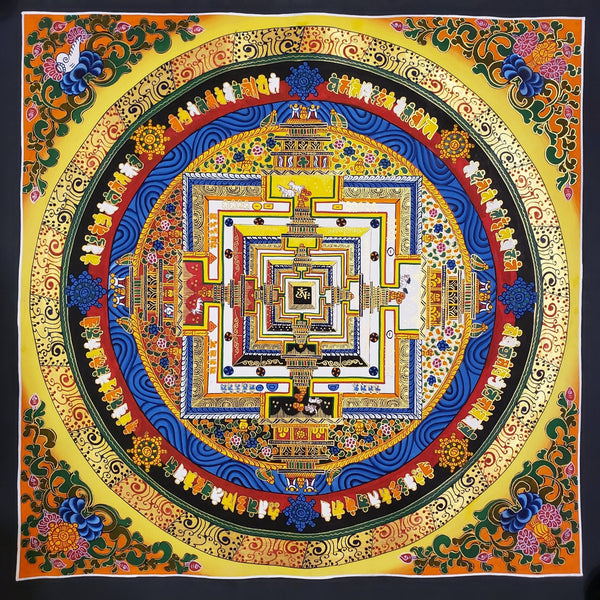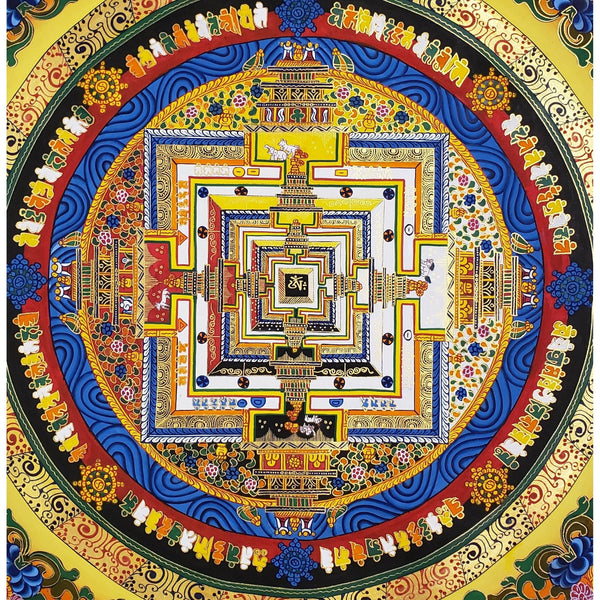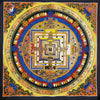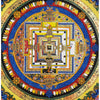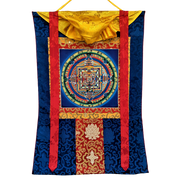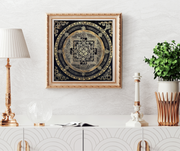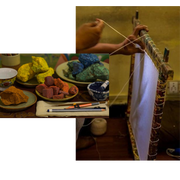Kalachakra Mandala Tibetan Thangka Painting
Get it between -

Kalachakra Mandala Thangka – Symbol of Time and Enlightenment
The Kalachakra Mandala Thangka is an exquisite and symbolic representation of the Kalachakra Tantra, one of the most advanced and complex teachings in Tibetan Buddhism. As His Holiness the Dalai Lama has emphasized, the Kalachakra initiations empower disciples to enter into the sacred Kalachakra mandala and identify with the deity Kalachakra. This hand-painted Thangka, created using Tibetan gold dust and natural pigments on organic cotton canvas, is a powerful tool for meditation and spiritual growth.
Specifications
- Dimensions: 55 x 55 cm
- Materials: Tibetan Gold Dust with Tibetan Colors
- Canvas: Organic Cotton
- Hand Painted in Nepal
- Master Quality Tibetan Thangka
A Sacred Guide to Enlightenment
Placing the Kalachakra Mandala Thangka in your home, office, or meditation space infuses the environment with positive, healing energy. Sacred geometry like the Kalachakra mandala raises vibrations, transforming the energy around it and supporting personal growth.
About the Kalachakra Tantra and Mandala
The Kalachakra Tantra is a profound body of teachings in Tibetan Buddhism that focuses on the cyclical nature of time and the transformation of the self into an enlightened being. Kalachakra, the deity at the center of this practice, is the personification of time and represents the endless passage of cycles, from life to death and rebirth. His form is that of a black-skinned, four-faced god with twelve arms and twenty-four hands, signifying his power over the flow of time.
The Kalachakra Mandala is a symbolic two-dimensional representation of the three-dimensional palace of Kalachakra. At the center, Kalachakra himself resides, surrounded by 722 deities. The mandala is composed of multiple palatial floors, each symbolizing an aspect of enlightened consciousness:
- Enlightened Body
- Enlightened Speech
- Enlightened Mind
- Enlightened Wisdom
- Enlightened Great Bliss
Around the palace, four elemental rings (Earth, Water, Fire, and Wind) and two outer rings (Space and Wisdom) form a complete microcosm of the universe, ruled by Kalachakra, the embodiment of time.
Symbolism of the Kalachakra Mandala
The Kalachakra Mandala is not merely a work of art but also a sacred tool for meditation, guiding the practitioner through deep spiritual insight. Through meditation on the mandala, monks strive to embody the qualities of the deity and enter the mandala, achieving union with Kalachakra. The sand mandala version of the Kalachakra is used in rituals and destroyed after completion to symbolize the impermanence of reality.
The Kalachakra Mandala is a representation of time as cyclical, reflecting the non-linear nature of time in Buddhist and Hindu cosmology. It highlights the interconnectedness of all aspects of existence and promotes the inner transformation of the practitioner.
The Story of Kalachakra's Origin
The Kalachakra Tantra was first taught by the Buddha on Vulture Peak in Northern India, where he simultaneously recited the Prajnaparamita Sutra and delivered the Kalachakra teachings to King Suchandra of the Shambhala Kingdom. Shambhala is a sacred mythical land symbolizing virtue, piety, and the protection of Buddhism. The kings of Shambhala were fierce protectors of the Dharma and spread the teachings of Buddhism far and wide.
Key Benefits:
- Spiritual Transformation: The Kalachakra Mandala serves as a powerful tool for meditation, guiding practitioners toward enlightenment by connecting them to the deity Kalachakra and the eternal cycles of time.
- Symbol of Peace: The teachings of Kalachakra, as promoted by His Holiness the Dalai Lama, are seen as a means to promote world peace and harmony through deep spiritual understanding and compassion.
- Healing and Balance: This mandala balances the mind, body, and spirit, offering a sense of peace and equilibrium to its viewers.
- Cultural Significance: As part of the Tibetan Buddhist tradition, this Thangka embodies centuries of artistic heritage and spiritual depth, crafted with meticulous care in Nepal using natural materials.
-
Artistic Mastery: Crafted with Tibetan gold dust and natural pigments, this Thangka is a masterpiece that showcases the skilled artistry and rich heritage of Tibetan craftsmanship.
You can find answers to common questions on our FAQ page here.
View all our shop reviews at reviews page here.

